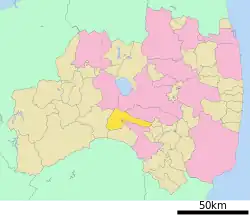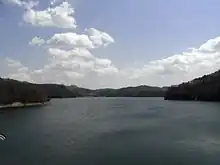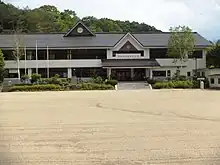Ten'ei
天栄村 | |
|---|---|
 Ten'ei Village Hall | |
 Flag  Seal | |
 Location of Ten'ei in Fukushima Prefecture | |
 Ten'ei | |
| Coordinates: 37°15′19.4″N 140°14′49.5″E / 37.255389°N 140.247083°E | |
| Country | Japan |
| Region | Tōhoku |
| Prefecture | Fukushima |
| District | Iwase |
| Area | |
| • Total | 225.52 km2 (87.07 sq mi) |
| Population (January 2020) | |
| • Total | 5,258 |
| • Density | 23/km2 (60/sq mi) |
| Time zone | UTC+9 (Japan Standard Time) |
| Phone number | 0248-82-2111 |
| Address | 78 Shimomatsumoto Harabatake, Ten'ei-mura, Iwase-gun, Fukushima-ken 962-0492 |
| Climate | Dfb |
| Website | Official website |
| Symbols | |
| Bird | Japanese bush warbler |
| Flower | Gentiana scabra |
| Tree | Styphnolobium japonicum, pine |

Ten-ei (天栄村, Ten-ei-mura) is a village located in Fukushima Prefecture, Japan. As of 1 January 2020, the village had an estimated population of 5,258 in 1717 households,[1] and a population density of 23 persons per km2. The total area of the village was 225.52 square kilometres (87.07 sq mi).
Geography
Ten-ei is located in south-central Fukushima prefecture. The village spans the Pacific side of the Abukuma River watershed and the Sea of Japan side of the Agano River watershed across the Ou Mountains. Hatori Dam is located in the village, which supplies agricultural water to the Shirakawa area of the Abukuma River basin and golf courses, campgrounds, skiing around the reservoir. There are many of traditional hot springs in the village.
- Mountains: Futamatayama (1544 m)
- Rivers: Shakado River, Tsurunuma River
Neighboring municipalities
Climate
Ten-ei has a humid climate (Köppen climate classification Cfa). The average annual temperature in Ten-ei is 10.8 °C (51.4 °F). The average annual rainfall is 1,328 mm (52.3 in) with September as the wettest month. The temperatures are highest on average in August, at around 23.8 °C (74.8 °F), and lowest in January, at around −1.1 °C (30.0 °F).[2]
| Climate data for Yumoto, Ten-ei (1991−2020 normals, extremes 1988−present) | |||||||||||||
|---|---|---|---|---|---|---|---|---|---|---|---|---|---|
| Month | Jan | Feb | Mar | Apr | May | Jun | Jul | Aug | Sep | Oct | Nov | Dec | Year |
| Record high °C (°F) | 12.3 (54.1) |
14.7 (58.5) |
20.3 (68.5) |
27.2 (81.0) |
30.6 (87.1) |
30.3 (86.5) |
32.9 (91.2) |
34.4 (93.9) |
31.1 (88.0) |
26.3 (79.3) |
21.8 (71.2) |
18.6 (65.5) |
34.4 (93.9) |
| Mean daily maximum °C (°F) | 1.4 (34.5) |
2.4 (36.3) |
6.4 (43.5) |
13.7 (56.7) |
19.2 (66.6) |
21.9 (71.4) |
25.4 (77.7) |
26.5 (79.7) |
22.1 (71.8) |
16.5 (61.7) |
10.9 (51.6) |
4.6 (40.3) |
14.3 (57.7) |
| Daily mean °C (°F) | −2.4 (27.7) |
−2.0 (28.4) |
1.2 (34.2) |
7.2 (45.0) |
12.7 (54.9) |
16.6 (61.9) |
20.5 (68.9) |
21.3 (70.3) |
17.2 (63.0) |
11.2 (52.2) |
5.2 (41.4) |
0.2 (32.4) |
9.1 (48.4) |
| Mean daily minimum °C (°F) | −6.6 (20.1) |
−6.6 (20.1) |
−3.4 (25.9) |
1.1 (34.0) |
6.3 (43.3) |
11.9 (53.4) |
16.7 (62.1) |
17.4 (63.3) |
13.3 (55.9) |
6.6 (43.9) |
0.2 (32.4) |
−3.8 (25.2) |
4.4 (40.0) |
| Record low °C (°F) | −18.7 (−1.7) |
−18.3 (−0.9) |
−17.0 (1.4) |
−7.8 (18.0) |
−2.8 (27.0) |
0.4 (32.7) |
6.2 (43.2) |
8.4 (47.1) |
−0.3 (31.5) |
−4.7 (23.5) |
−9.2 (15.4) |
−15.9 (3.4) |
−18.7 (−1.7) |
| Average precipitation mm (inches) | 96.0 (3.78) |
62.2 (2.45) |
99.3 (3.91) |
106.1 (4.18) |
121.8 (4.80) |
162.2 (6.39) |
218.4 (8.60) |
193.6 (7.62) |
224.8 (8.85) |
171.5 (6.75) |
81.5 (3.21) |
94.6 (3.72) |
1,634.5 (64.35) |
| Average snowfall cm (inches) | 195 (77) |
159 (63) |
128 (50) |
15 (5.9) |
0 (0) |
0 (0) |
0 (0) |
0 (0) |
0 (0) |
0 (0) |
10 (3.9) |
118 (46) |
610 (240) |
| Average precipitation days (≥ 1.0 mm) | 16.1 | 12.9 | 13.3 | 11.0 | 11.3 | 13.7 | 15.6 | 13.8 | 13.1 | 11.2 | 11.4 | 14.8 | 158.2 |
| Average snowy days (≥ 3 cm) | 18.2 | 16.2 | 15.8 | 1.8 | 0 | 0 | 0 | 0 | 0 | 0 | 1.0 | 10.7 | 63.7 |
| Mean monthly sunshine hours | 78.9 | 104.2 | 153.5 | 180.7 | 194.2 | 143.8 | 140.4 | 166.8 | 125.7 | 126.6 | 107.8 | 84.1 | 1,606.5 |
| Source: Japan Meteorological Agency[3][4] | |||||||||||||
Demographics
Per Japanese census data,[5] the population of Ten-ei has declined over the past 70 years.
| Year | Pop. | ±% |
|---|---|---|
| 1950 | 10,590 | — |
| 1960 | 9,165 | −13.5% |
| 1970 | 7,324 | −20.1% |
| 1980 | 6,820 | −6.9% |
| 1990 | 6,964 | +2.1% |
| 2000 | 6,889 | −1.1% |
| 2010 | 6,291 | −8.7% |
| 2020 | 5,194 | −17.4% |
History
The area of present-day Ten-ei was part of ancient Mutsu Province and formed part of the holdings of Shirakawa Domain during the Edo period. After the Meiji Restoration, it was organized as part of Iwase District in the Nakadōri region of Iwashiro Province. The villages of Makimoto, Yumoto, Oya and Hiroto were established on April 1, 1889, with the creation of the modern municipalities system. The village of Ten-ei was formed on March 31, 1955, with the merger of the villages of Makimoto, Yumoto, and a portion of Hiroto with the village of Osato.
Its population was above 10,000 in the 1950s, and this was the highest its population ever was.[6]
Many of the houses in the village suffered severe damage from the 2011 Tohoku earthquake, after which Ten-ei has experienced accelerated population decline. Additional population losses before and after the earthquake were due to the community being far from key sites.[6]
Economy
In the 1950s the economy of Ten’ei was primarily made up of factories and agricultural operations.[6] Ten-ei circa 2023 is majority agricultural, with Yacón a noteworthy crop.
Education

Ten-ei has four public elementary schools and one public junior high school operated by the village government. The village does not have a high school.
Junior high schools:[7]
- Ten-ei Junior High School (天栄村立天栄中学校)
- Yumoto Junior High School (天栄村立湯本中学校; closed in 2023) - The building was two stories tall. Its peak population was in the 1960s. A sharp population decline occurred after 2000. The population loss resulted in it closing in 2023, with its final graduating class having two students.[6]
Elementary schools:[7]
- Hiroto Elementary School (天栄村立広戸小学校)
- Makimoto Elementary School (天栄村立牧本小学校)
- Osato Elementary School (天栄村立大里小学校)
- Yumoto Elementary School (天栄村立湯本小学校)
Kindergartens:[7]
- Ten-ei Kindergarten (天栄幼稚園)
 Yumoto Junior High School (closed 2023)[6]
Yumoto Junior High School (closed 2023)[6]
Transportation
Railway
- Ten-ei does not have any passenger railway service.
| No | Terminus | Via | Terminus | Company | Note |
|---|---|---|---|---|---|
| 112 | Sukagawa Station | Kagamiishi Station | Fumata Onsen | Fukushima Transportation | Runs only summer. |
| 119 | Shin-Shirakawa Station | Taishichoshamae(Gishu Nakayama Memorial Library)·Takabayashi | Maki-no-uchi | ||
| 113 | Sukagawa Station | Kagamiishi Station | Naganuma koko | ||
| 114 | Sukagawa Station | Kagamiishi Station | Ryusei | ||
| 115 | Sukagawa Station | Kagamiishi Station | Maruyama Shako | ||
| 111 | Sukagawa Station | Kagamiishi Station | Minamisawa | ||
| 1 | Funahiki Station | Kodo/Kawauchi | |||
| Yakon | Shin-Shirakawa Station | Saigo BS·Lake Hatori Kogenguchi·Iwase-Yumoto Onsen | Futamata Onsen | Runs only during winter. You must reserve the bus |
Highway
Local attractions
- Hatori Dam
- Futamata Hot Spring
- Yumoto Hot Spring
- Ten’ei Hot Spring
- Hatoriko Hot Spring and ski resort
References
- ↑ Ten-ei official statistics(in Japanese)
- ↑ Ten-ei climate data
- ↑ 観測史上1~10位の値(年間を通じての値). JMA. Retrieved March 21, 2022.
- ↑ 気象庁 / 平年値(年・月ごとの値). JMA. Retrieved March 21, 2022.
- ↑ Ten-ei population statistics
- 1 2 3 4 5 Yamamitsu, Eimi; Bateman, Tom; Kato, Issei. "Last students graduate: School closures spread in ageing Japan". Reuters. Retrieved 2023-03-30.
- 1 2 3 "Home". Ten-ei Education Network. Retrieved 2023-04-02.
External links
 Media related to Ten'ei, Fukushima at Wikimedia Commons
Media related to Ten'ei, Fukushima at Wikimedia Commons- Official website (in Japanese)
- Schools close across rural Japan as birth rate plummets - YouTube